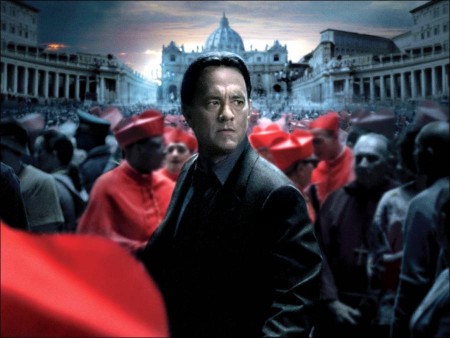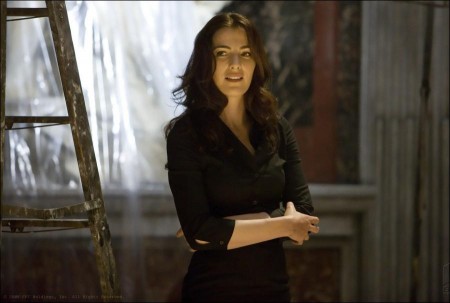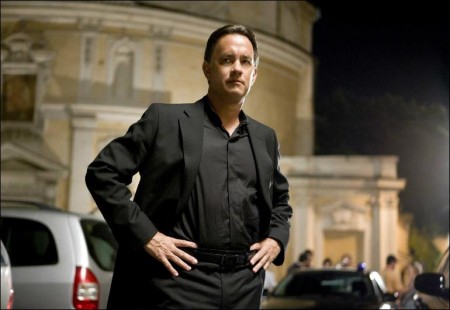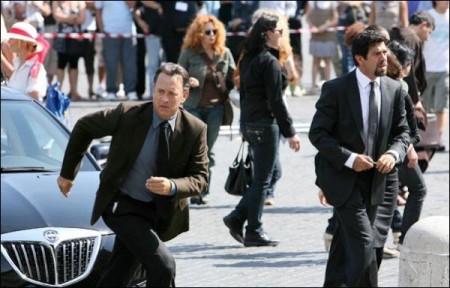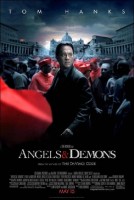About the Story
Under the watchful eyes of Father Silvano Bentivoglio (Carmen Argenziano) and Dr. Vittoria Vetra (Ayelet Zurer), the European Organization for Nuclear Research (CERN) initiates the Large Hadron Collider and creates three vials of antimatter particles larger than any that have ever been produced before. Almost immediately, Father Silvano is killed and one of the vials of antimatter goes missing. At the same time, the Roman Catholic Church is mourning the sudden death of Pope Pius XVI in Rome and prepares for the papal conclave to elect the next Pope.
The Camerlengo Patrick McKenna (Ewan McGregor) assumes temporary control of the Vatican. The Illuminati kidnap four of the ‘preferiti’ (the favourite cardinals to be elected pope) before the conclave enters seclusion and threaten to kill one candidate every hour and destroy all of Vatican City at midnight, using the missing vial of antimatter as a bomb. The Vatican summons symbologist Robert Langdon (Tom Hanks) from Harvard University and Vittoria from CERN to help them save the four preferiti and locate the vial.
Langdon listens to the Illuminati’s message and deduces that the four cardinals will die at the four altars of the “Path of Illumination,” marked by statues of angels in locations relevant to the four classical elements. Over the objections of Commander Maximilian Richter (Stellan Skarsgård), head of the Swiss Guard, but with McKenna’s consent, Langdon is granted access to the Vatican Secret Archives. He examines Galileo Galilei’s banned book with Vetra. Following the clues and accompanied by Inspector General Ernesto Olivetti (Pierfrancesco Favino), and Claudio Vincenzi (David Pasquesi) of the Vatican Gendarmerie Corps, they arrive at the Chigi Chapel in the Church of Santa Maria del Popolo. There they find Cardinal Ebner (Curt Lowens) dead, suffocated with soil and branded with an ambigrammatic word “Earth”. They verify the second location is Saint Peter’s Square but are unable to save Cardinal Lamassé (Franklin Amobi); his lungs punctured and his body branded with “Air”.
While Vetra studies Silvano’s diaries, Langdon, Olivetti and Vincenzi locate the third church, Santa Maria della Vittoria, but are unable to save Cardinal Guidera (Bob Yerkes) from being burned to death. His body is branded with an ambigrammatic word, “Fire”. The assassin (Nikolaj Lie Kaas) appears and kills Olivetti and Vincenzi, while Langdon barely manages to escape with his life.
Langdon and two Carabinieri officers (Victor Alfieri and Todd Schneider) race to the Water altar, the Fountain of the Four Rivers, where the assassin murders the officers and drops a bound and weighted Cardinal Baggia (Marco Fiorini) into the fountain. Langdon, assisted by bystanders, saves the cardinal, who tells him the Illuminati’s lair is Castel Sant’Angelo. There Langdon and Vetra discover a hidden passageway leading to the Vatican, being used as a hideout for the assassin. Discovering a case with marks for five branding irons, they realize the fifth brand is for the camerlengo but are confronted by the assassin before they can alert McKenna. The assassin spares their lives, then cryptically warns them that his contractors were “men of God”. He escapes but is then killed when his car explodes.
Inside the Vatican, Langdon and Vetra find Commander Richter hovering over McKenna with a gun, the Vatican symbol branded into McKenna’s chest. Richter and Archbishop Simeon (Cosimo Fusco) are shot by the Guards, and Langdon takes a key that slips from Richter’s hand. The stolen antimatter vial is found in St. Peter’s Tomb below the church, but the battery life is too low to risk re-connecting it to a battery. McKenna, a former military pilot, seizes the vial and uses an awaiting helicopter to fly above the Vatican.
At a high altitude, he parachutes out as the antimatter bomb explodes overhead. McKenna is hailed a hero and savior, and the cardinals move to elect him pope. Langdon and Vetra use Richter’s key to watch a security video showing McKenna speaking to Richter before the attack. The video reveals that it is McKenna, not the Illuminati, who masterminded the scheme; McKenna intended to use the incident to be named Pope and to rally the church’s most conservative followers to his side. The recording is shown to the Papal conclave, and when it dawns on McKenna that he has been exposed he flees to a remote recess in the building where he is able to commit suicide by setting himself on fire.
The Vatican officially announces that McKenna died due to internal injuries suffered during his parachute landing, and Cardinal Baggia is named Pope Luke, with Cardinal Strauss as the new camerlengo. Strauss thanks Langdon for his assistance and gives Langdon Galileo’s “Diagramma Veritatis” for his research, requesting only that Langdon’s will contain a bequest that it be returned to the Vatican, and that any future references he makes about the Catholic Church in his future publications be done “gently”.
Filming
Shooting began on June 4, 2008 in Rome under the fake working title Obelisk. The filmmakers scheduled three weeks of exterior location filming because of a predicted 2008 Screen Actors Guild strike on June 30. The rest of the film would be shot at Sony Pictures Studios in Culver City, California, to allow for this halt. Roman Catholic Church officials found The Da Vinci Code offensive and forbade filming in their churches, so these scenes were shot at Sony. The Caserta Palace doubled for the inside of the Vatican, and the Biblioteca Angelica was used for the Vatican Library. Filming took place at the University of California, Los Angeles in July. Sony and Imagine Entertainment organized an eco-friendly shoot, selecting when to shoot locations based on how much time and fuel it would save, using cargo containers to support set walls or greenscreens, as well as storing props for future productions or donating them to charity.
Howard hated that the Writers Guild strike forced him to delay shooting the film until summer. However, the quick shoot allowed him to refine the naturalism he had employed on his previous film Frost/Nixon, often using handheld cameras to lend an additional energy to the scenes.
Hanks interrupted filming of one scene in order to help Australian bride Natalia Dearnley get through the crowds to her wedding on time. McGregor said the Pope’s funeral was the dullest sequence to film, as they were just walking across staircases. Then, “Someone started singing ‘Bohemian Rhapsody’ [and] it became the funeral theme tune.”
When recreating the interior of St. Peter’s Basilica, production designer Allan Cameron and visual effects supervisor Angus Bickerton recognized the 80 feet tall soundstages were only half the size of the real church. They rebuilt the area around and the crypts beneath St. Peter’s baldachin, including the bottoms of the columns and Saint Peter’s statue, and surrounded it with a 360 degree greenscreen so the rest could be built digitally.
Cameron had twenty crew members, posing as members of the public, photograph as much as they could inside the Sistine Chapel, and had artists sketch, photograph and enlarge recreations of the paintings and mosaics from the photographs. Cameron chose to present the Sistine Chapel as it was before it was cleaned up, because he preferred the contrast the smoky, muted colors would present with the cardinals. Although the chapel was built to full size, the Sala Regia was made smaller to fit inside the stage.
The Saint Peter’s Square and the Piazza Navona sets were built on the same backlot; after completion of scenes at the former, six weeks were spent converting the set, knocking down the Basilica side and excavating 3½ feet of tarmac to build the fountain. As there had been filming at the real Piazza Navona, the transition between it and the replica had to be seamless. To present the Santa Maria del Popolo undergoing renovation, a police station in Rome opposite the real church was used for the exterior; the scaffolding would hide that it was not the church.
Cameron built the interior of Santa Maria del Popolo on the same set as the recreated Santa Maria della Vittoria to save money; the scaffolding also disguised this. The film’s version of Santa Maria della Vittoria was larger than the real one, so it would accommodate the cranes used to film the scene. To film the Pantheon’s interior, two aediculae and the tomb of Raphael were rebuilt to scale at a height of 30 feet, while the rest was greenscreen. Because of the building’s symmetrical layout, the filmmakers were able to shoot the whole scene over two days and redress the real side to pretend it was another. The second unit took photographs of the Large Hadron Collider and pasted these in scenes set at CERN.
Production notes provided by Columbia Pictures.
Angels and Demons
Starring: Tom Hanks, Ewan McGregor, Ayelet Zurer, Stellan Skarsgard, Pierfrancesco Favino, Nikolaj Lie Kaas
Directed by: Ron Howard
Screenplay by: Akiva Goldsman
Release Date: May 15th, 2009
MPAA Rating: PG-13 for sequences of violence, disturbing images and thematic material
Studio: Columbia Pictures
Box Office Totals
Domestic: $133,375,846 (27.5%)
Foreign: $351,002,614 (72.5%)
Total: $484,378,460 (Worldwide)

